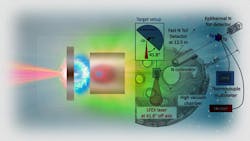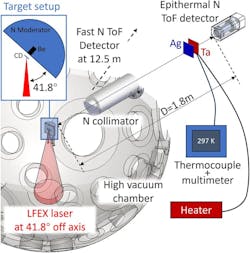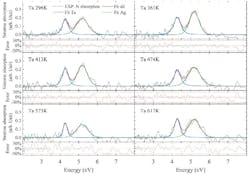Neutron-Based Scheme Yields Nanosecond-Speed Temp Measurement
What you’ll learn:
- Why and where temperature measurement within a nanosecond-scale window may be needed.
- The arrangement that provided accurate temperature readings in this time span and how it works.
- The results achieved with this system.
One broad guideline that engineers learn early in their test-and-measurement roles is that temperature generally doesn’t change quickly, especially relative to an electronic circuit’s operating speed. Due to thermal mass and other considerations, the typical time scale associated with temperature measurements is rarely quicker than milliseconds and is often orders of magnitude slower.
Nonetheless, as temperature is the most widely measured and critical real-world physical parameter, there are exceptions and situations where you need to know the temperature within a far shorter time window.
Countless contact and non-contact ways can be employed to measure temperature using relatively basic sensors, from thermocouples, RTDs, thermistors, and solid-state devices all the way to infrared scanners and even laser-based schemes. Each has its own set of attributes and reading time scale. However, these established approaches generally don’t solve the ultra-high-speed measurement challenge.
Neutron-Based Technique Speeds Temp Measurement
In a project led by Osaka University (Japan), neutrons were used to measure temperatures quickly and accurately, which could eventually lead to improved performance for all kinds of electronics. While there have been a few ways to estimate the temperature inside an electronic device, none have been able to give a fast, direct measurement.
This new method uses a technique called neutron resonance absorption (NRA). By examining neutrons being absorbed by atomic nuclei at certain energy levels, the properties of the material can be deduced (Fig. 1).
A laser pulse (LFEX) with an intensity of ~1 × 1019 W/cm2 was focused on a 5-µm-thick deuterated polystyrene (CD) foil to accelerate protons and deuterons. The neutrons were generated using high-intensity laser beams and the ions were injected into a secondary target, a beryllium (Be) cylinder with 10-mm diameter and a 10-mm thickness. The neutrons were then decelerated to a very low energy level before being passed through a sample.
They measured Doppler broadening of the NRA generated with a single neutron pulse provided by the laser. They demonstrated that the Doppler width of the resonance absorption of a tantalum (specifically stable isotope Ta181) increases as the square root of the sample temperature according to a theoretical model.
The time-of-flight (ToF) method was used to determine neutron energy by calculation with a known neutron flight distance and time. Each Doppler spectrum was acquired from a single pulse of a laser.
The technique was tested using plates of tantalum and silver, successfully returning details about the materials and temperatures with exceptional speed (Fig. 2). The researchers could determine the temperature of the samples because the temporal signal of the NRA was altered in a predictable manner when the sample material’s temperature was changed.
Near-Real-Time Temp Measurement of Material Changes
As the NRA measurement is performed with a single pulse of neutrons, the newly developed technique can acquire temperature data within a window of just 100 ns. This near-instant result means changes within a material can be measured in close to real time, allowing new types of detailed analysis. This result indicates the possibility that a laser-driven neutron source (LDNS) may provide a real-time thermometry of a nuclide that probes the instantaneous temperature of dynamic objects.
While their general technique isn’t new, their implementation breaks new ground. “Using lasers to generate and accelerate ions and neutrons is nothing new, but the techniques we’ve developed in this study represent an exciting advance,” said senior author Akifumi Yogo. “We expect that the high temporal resolution will allow electronics to be examined in greater detail, help us to understand normal operating conditions, and pinpoint abnormalities.”
“This technology makes it possible to instantaneously and accurately measure temperature,” added Zechen Lan, lead author. “As our method is non-destructive, it can be used to monitor devices like batteries and semiconductor devices.”
Their paper “Single-shot laser-driven neutron resonance spectroscopy for temperature profiling,” published in Nature Communications, details the arrangement as well as the underlying physics principles. The paper also identifies the many real-world subtleties that they had to take into account, accommodate, or work around.
The scheme isn’t for those seeking a quick, simple, or inexpensive measurement, but it does provide a temperature reading that’s difficult, if not impossible, to obtain otherwise. While it may be hard to believe by looking at the dimensions in their schematic diagram, the researchers note that their measurement device is about a tenth of the size of other similar equipment. As a result, it will be easier (although actually not easy, of course) for laboratories elsewhere to install their own versions.
The project certainly shows technical innovation and the lengths to which researchers will go, literally and figuratively, to achieve challenging goals.
About the Author

Bill Schweber
Contributing Editor
Bill Schweber is an electronics engineer who has written three textbooks on electronic communications systems, as well as hundreds of technical articles, opinion columns, and product features. In past roles, he worked as a technical website manager for multiple topic-specific sites for EE Times, as well as both the Executive Editor and Analog Editor at EDN.
At Analog Devices Inc., Bill was in marketing communications (public relations). As a result, he has been on both sides of the technical PR function, presenting company products, stories, and messages to the media and also as the recipient of these.
Prior to the MarCom role at Analog, Bill was associate editor of their respected technical journal and worked in their product marketing and applications engineering groups. Before those roles, he was at Instron Corp., doing hands-on analog- and power-circuit design and systems integration for materials-testing machine controls.
Bill has an MSEE (Univ. of Mass) and BSEE (Columbia Univ.), is a Registered Professional Engineer, and holds an Advanced Class amateur radio license. He has also planned, written, and presented online courses on a variety of engineering topics, including MOSFET basics, ADC selection, and driving LEDs.


